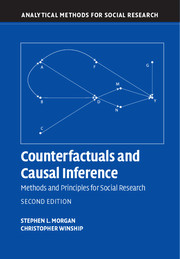Book contents
- Frontmatter
- Dedication
- Contents
- List of Figures
- List of Tables
- Acknowledgments for First Edition
- Acknowledgments for Second Edition
- I Causality and Empirical Research in the Social Sciences
- II Counterfactuals, Potential Outcomes, and Causal Graphs
- III Estimating Causal Effects by Conditioning on Observed Variables to Block Back-Door Paths
- IV Estimating Causal Effects When Back-Door Conditioning Is Ineffective
- 8 Self-Selection, Heterogeneity, and Causal Graphs
- 9 Instrumental Variable Estimators of Causal Effects
- 10 Mechanisms and Causal Explanation
- 11 Repeated Observations and the Estimation of Causal Effects
- V Estimation When Causal Effects Are Not Point-Identified by Observables
- VI Conclusions
- References
- Index
11 - Repeated Observations and the Estimation of Causal Effects
Published online by Cambridge University Press: 05 December 2014
- Frontmatter
- Dedication
- Contents
- List of Figures
- List of Tables
- Acknowledgments for First Edition
- Acknowledgments for Second Edition
- I Causality and Empirical Research in the Social Sciences
- II Counterfactuals, Potential Outcomes, and Causal Graphs
- III Estimating Causal Effects by Conditioning on Observed Variables to Block Back-Door Paths
- IV Estimating Causal Effects When Back-Door Conditioning Is Ineffective
- 8 Self-Selection, Heterogeneity, and Causal Graphs
- 9 Instrumental Variable Estimators of Causal Effects
- 10 Mechanisms and Causal Explanation
- 11 Repeated Observations and the Estimation of Causal Effects
- V Estimation When Causal Effects Are Not Point-Identified by Observables
- VI Conclusions
- References
- Index
Summary
As discussed in previous chapters, the fundamental challenge of causal inference is that an individual cannot be simultaneously observed in both the treatment and control states. In some situations, however, it is possible to observe the same individual or unit of observation in the treatment and control states at different points in time. If the potential outcomes do not evolve in time for reasons other than the treatment, then the causal effect of a treatment can be estimated as the difference between an individual's observed outcome in the control state at time 1 and the same individual's observed outcome in the treatment state at time 2. The assumption that potential outcomes are stable in time (and thus age for individuals) is often heroic. If, however, potential outcomes evolve in a predictable way, then it may be possible to use the longitudinal structure of the data to predict the counterfactual outcomes of each individual.
We begin our discussion with the interrupted time series (ITS) design, which we introduced already with the example of the year of the fire horse in Section 2.8.1. The ITS design is the simplest case where the goal is to determine the degree to which a treatment shifts the underlying trajectory of an outcome.
- Type
- Chapter
- Information
- Counterfactuals and Causal InferenceMethods and Principles for Social Research, pp. 354 - 416Publisher: Cambridge University PressPrint publication year: 2014
- 1
- Cited by

